
Allium, Ornamental Onion: Planting, Growing and Care
Contents
Allium in a nutshell
- The flowering of Alliums, with their beautiful spherical blooms, is spectacular
- From late spring onwards, it’s decorative both in borders and as a cut flower
- It looks stunning right from the first year of planting
- Ornamental garlic thrives easily in sunny spots with well-drained soil
- Being hardy, it remains in the ground year after year
Our expert's word
Highly prized for their unconventional spring or summer blooms in spheres of blue, purple, white, pink or yellow, measuring 5 to 30 cm in diameter and perched atop tall stems, Alliums or ornamental onions deserve a place in every naturalistic or contemporary-style garden. Their striking verticality adds depth and movement to flower beds.
Allium giganteum, Allium schubertii or Allium Gladiator, Allium ‘Purple Sensation‘, white Allium or yellow Allium molly, all are perfectly hardy, remain in place year after year and thrive in sunny spots with well-drained soil.
Once fallen out of fashion, they are making a comeback in our gardens to structure sunny borders effortlessly. They are best planted en masse in the middle or at the back of borders, along edges, in rockeries or in pots. They are fabulous in dry gardens.
Easy to pair, they form beautiful clumps of colour with magnificent floriferousness, alongside various perennials, roses, ornamental grasses or other bulbs like tulips.
Discover our Allium collections, along with advice on planting, caring for and pairing them in the garden.
Description and botany
Botanical data
- Latin name Allium
- Family Alliaceae
- Common name Ornamental onion
- Flowering April to July
- Height 0.15 to 1.50 m
- Exposure Full sun
- Soil type all types, well-drained
- Hardiness -15°C
The Allium genus includes approximately 700 species of bulbous or rhizomatous perennials native to dry and mountainous regions of Europe and Asia, some of which are edible like its relatives garlic (including the well-known Allium ursinum or wild garlic), onion (Allium cepa), shallot, chives (Allium schoenoprasum) and leek.
Apart from these vegetable species, around twenty ornamental onion species are commonly cultivated throughout France in gardens for the beauty of their spherical or loose flower heads perched atop slender yet sturdy stems.
Their growth habit varies, from architectural to ground-covering: Alliums are divided into tall species (0.80 m to 1.50 m in height), medium (0.45 to 0.75 m) and low (0.20 to 0.40 m), and according to their flower diameter ranging between 5 and 40 cm. Tall species bloom in large spherical umbels, while most low species produce loose umbels.
This bulbous perennial develops from a single bulb. Fast-growing, it can reach up to 1.50 m in height when flowering under optimal conditions, and will spread via bulbils that eventually form clumps. We distinguish between bulbous Alliums and rhizomatous species that develop on short, fleshy rhizomes.
Once established, they will flower for many years, with some naturalising easily and even becoming invasive in certain regions (Allium triquetrum).
In March-April, the bulb produces a clump of deciduous leaves or more or less evergreen depending on winter severity, ribbon-like or linear, more or less narrow, sometimes hairy, basal or sheathing the stems. They are shorter than the flower stalk. In ground-covering species, they sometimes form a grass-like foliage clump. Composed of basal leaves 7 to 60 cm long, medium green to grey-green in colour, the foliage yellows, withers, and often disappears before or as flowering begins. The leaves emit a strong garlic scent only when crushed.
The flower stalk emerges from this dense grassy clump, quickly rising sometimes over 1 m high. The stems are sturdy and very rigid, smooth or wrinkled and leafless. Green or sometimes tinged purple depending on variety, they bear inflorescences at their tip, typically spherical umbels, sometimes semi-spherical or pendulous, measuring from 1 up to 30 cm in diameter.
From April to July-August depending on variety, flowers appear atop these slender stems. They offer varied hues from bright blue to amethyst, purple-red, red through to white and golden yellow. In some Alliums, petals feature a central vein and darker-hued centre adding great depth to the flower.
Their shape varies by species, from the voluminous, spectacular globes of Allium christophii to the airy umbels of Allium carinatum ssp pulchellum.
Tall species bear perfectly round, compact umbels 5 to 30 cm across, composed of small star-shaped 6-petalled flowers (sometimes hundreds) or bell-shaped blooms radiating from a central point.
Some flowers have differently sized pedicels, like Allium schubertii sometimes called “firework onion” which has large spherical umbels with a spidery structure. Flowers attach alternately to long and short pedicels.
Others feature umbels curiously topped by small distinct flowers on long stalks, resembling upright tufts. The umbels of Allium sphaerocephalon form tight pom-poms. Allium ‘Hair’ is a true curiosity with its hairy, dishevelled blooms.
Low-growing species generally have lighter, more delicate umbels. Most flower in loose umbels of star-shaped flowers like Allium moly or golden garlic, bell-shaped often pendulous in Allium triquetrum or Allium cyathophorum var. farreri, or open cup-shaped in Allium neapolitanum. A few, like Allium karataviense and Allium senescens subsp. montanum form small spherical umbels just 30 cm high.
Allium flowers are nectar-rich and often emit a light sweet fragrance attracting many pollinators including butterflies.
Flowering lasts nearly 6 weeks. Later in summer, pollinated flowers dry on the stem, transforming into parchment-coloured seed heads that extend the decorative effect for at least 3 more months.
Except for Allium ursinum or wild garlic, which prefers partial shade in woodland, Alliums love warm, sunny spots, and all fresh, light, rather dry and especially well-drained soils, even poor or stony ones. They tolerate summer drought, coinciding with bulb dormancy.
Fully hardy, the bulbs can overwinter underground even in cold regions. They withstand temperatures down to -15°C and often lower in well-drained soil.
Visible from afar in the garden, the graphic inflorescences of ornamental onions make fabulous focal points in contemporary or cottage-style beds. With their spectacular large spherical heads, tall alliums structure borders. Low-growing or ground-covering species are perfect for edging wild gardens.
Allium can be used in rockeries, gravel gardens, behind boxwood balls, in isolated clumps or repeated patterns in sunny borders.
Pair them with graceful perennials and grasses like Lady’s mantle, Stipa, Carex, small hardy geraniums or bellflowers, Verbena bonariensis, columbines or Heucheras. They work wonders surrounded by valerian, thistles or gypsophila and combined with bulbs like late-flowering tulips and iris.
Alliums also pair beautifully with roses and peonies in borders.
They also make highly decorative container plants for terraces from spring to autumn.
Read also
Planting alliumsSpecies and main varieties
While there are over 700 species of Alliums, around forty are commonly cultivated in gardens.
Ornamental alliums are categorised by their height, divided into tall and short species. The tallest varieties easily reach 0.80 m to 1.50 m in height, medium-sized Alliums grow between 0.45 and 0.75 m, while the smallest species do not exceed 40 cm.
They also differ in form, with globular or loose umbels, and the diameter of their inflorescences, ranging from giant (30 cm across) to small (5 cm).
Alliums are incredibly striking bulbous plants, with strong decorative potential. Choosing an allium depends on its height, colour, and flower shape, as well as its intended location.
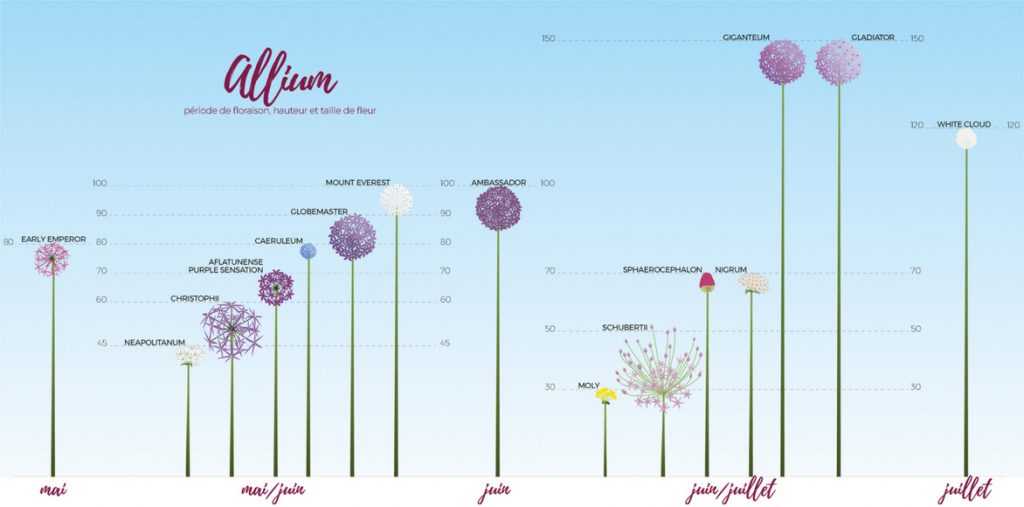
Alliums: main varieties classified by flowering period and height
Stunning when grouped in beds, rockeries or containers, alliums also make spectacular cut flowers for both fresh and dried bouquets.
From the most classic to the most unusual, explore our beautiful collection of alliums, including some exclusive varieties.
The most popular
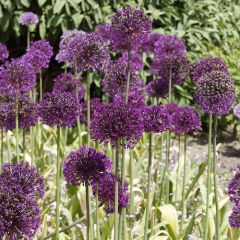
Allium aflatunense Purple Sensation
- Flowering time June, July
- Height at maturity 90 cm
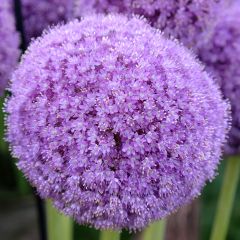
Allium giganteum
- Flowering time July, August
- Height at maturity 1,50 m
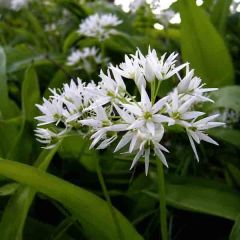
Allium ursinum tubers
- Flowering time May, June
- Height at maturity 20 cm
Our favourites
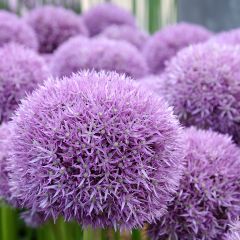
Allium Pinball Wizard
- Flowering time June, July
- Height at maturity 70 cm
Other interesting varieties
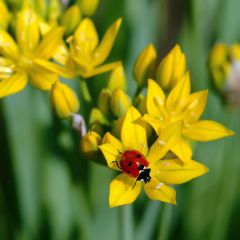
Allium moly
- Flowering time July, August
- Height at maturity 30 cm
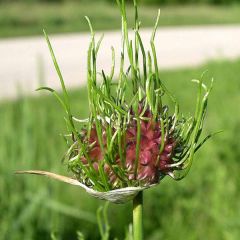
Allium vineale Hair
- Flowering time July, August
- Height at maturity 80 cm
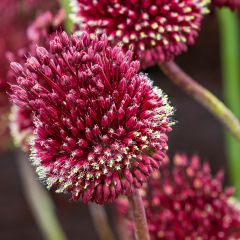
Allium amethystinum Red Mohican
- Flowering time July, August
- Height at maturity 95 cm
To make the right choice, explore our guide: “Allium, ornamental allium: which varieties to choose?”
Discover other Allium
Planting ornamental garlic
Where to Plant Allium Bulbs
Allium is an easy-to-grow bulb that thrives throughout France. With the exception of Allium ursinum (wild garlic), which prefers the cool shade of woodland, plant them in full sun, sheltered from strong winds to protect the stems of taller varieties.
Hardy and robust, Allium bulbs can be left in the ground. Planted under the right conditions, they will flower for many years. Give them a spot in well-drained soil, even stony ground, as they dislike excess moisture. They tolerate poor soil, though they may need a little fertiliser to bloom well.
Depending on their height—ranging from 0.20 to 1.50 metres—plant Allium bulbs in groups or as standalone features in the middle or back of perennial or shrub borders, along edges, in rockeries, or even in pots.
Large-flowered species and tall varieties like A. giganteum or A. Globemaster should be grouped at the back of perennial borders.
Low-growing species such as A. moly or A. sikkimense work wonders along edges, in rockeries, beside walls, or grown in pots or troughs on sunny terraces.
All alliums pair beautifully with grasses, roses, other bulbs like tulips, and a variety of perennials.
When to Plant Alliums
Allium bulbs are best planted in autumn, ideally before the end of October, to allow them time to establish and typically flower in late spring and early summer. Late planting is possible until the end of January for slightly delayed flowering. They are stunning even in their first year.
How to Plant Alliums
Plant Alliums in small groups for a natural look or in larger numbers for a spectacular display. Small and medium-sized bulbs (varieties reaching 20 cm to 75 cm) should be planted in clusters of 3 to 5 bulbs or at a density of 80 to 150 bulbs per m² for a flowering carpet. Large Allium bulbs should be planted in groups of 3, 5, 7, or more.
- Using a bulb planter, bury the bulbs 10 to 15 cm deep
- Space large bulbs 15 cm apart, and small bulbs about 5 cm apart
- Alliums need well-drained soil. If your soil is heavy, place a layer of sand or gravel directly beneath the bulb at the bottom of the planting hole to improve drainage
- Cover the bulbs with twice their height in soil
- Optionally, mark their location with a stick to find them after foliage dies back
To learn more about planting ornamental alliums, check out our practical guide: “Planting Alliums” and our step-by-step video tutorial.
Read also
How to preserve wild garlic and use it?Care and Maintenance
Very low-maintenance, Alliums require limited care and attention. Only water during the growing period if the soil is very dry. Keep the soil moist during the growing season then stop watering after flowering. Potted alliums have greater water needs: water regularly, but also stop watering in summer.
After flowering, you may be torn between cutting or leaving the spent flower stems. Pruning is not necessary. The faded heads of larger varieties can be left in place – as they dry out, they will continue to decorate flower beds until autumn, unless you wish to prevent self-seeding, in which case remove the faded flowers by cutting the stem as close to the ground as possible.
Discover our advice sheet on drying Allium flowers.
However, cutting back the faded flower heads of some smaller varieties will limit their spread, as some like Allium triquetrum or Wild Garlic (Allium ursinum) can sometimes become invasive.
Only cut back the foliage once it has completely withered and dried out, to allow the bulb time to replenish its reserves for the next flowering. You may wish to stake taller species if necessary to prevent stems from bending in the wind.
In spring, before flowering, you can optionally apply a bulb fertiliser if your soil is particularly poor.
Diseases and potential pests
Allium is a very hardy bulbous plant that rarely presents cultivation problems. When planted in poor growing conditions (heavy soil, excess water), it may become susceptible to certain attacks, particularly from the onion fly, which can cause the bulb to die. Destroy any affected bulbs. In poorly drained soil, the bulbs may sometimes be affected by white rot: discard any damaged or diseased bulbs.
Propagation
Allium can be propagated by seed or by dividing clumps. Sowing seeds is a method that, on one hand, doesn’t guarantee true-to-colour plants for hybrids and, on the other hand, requires considerable time before obtaining bulbs mature enough to flower. Division is the most efficient and easiest method to implement in the garden.
By seed
Sow purchased or collected seeds from dried flowers sparingly, either directly in the ground in late summer or autumn, or in a well-draining mix (compost, sand, potting soil) under a cold frame or in pots. Lightly cover with soil and keep the mixture moist until germination. They will sprout the following spring. This method is somewhat unpredictable and lengthy: seeds may not produce bulbs identical to the parent and won’t flower immediately. It will take 4 to 5 years for them to become attractive and floriferous.
By separating bulbils
You’ll quickly obtain new bulbs true to the parent plant. Dividing alliums should be done on plants that are at least 3 years old, in autumn, once the flowering cycle is fully complete.
- Lift the clump carefully with a garden fork
- Gently separate the bulbils from the mother bulb
- Replant the divided bulbs immediately in the ground or in pots to allow them time to grow well
Combining ornamental alliums
Versatile, Alliums are essential in a natural garden or contemporary border, creating striking, colourful displays. Majestic yet fleeting, they bloom from spring onwards, enhancing naturalistic borders, cottage gardens, and modern prairie-style plantings alike. They are classic choices for mixed borders, adding character and whimsy.
These trouble-free bulbous plants pair effortlessly with other perennials, rising majestically above them. Once flowering ends, their foliage withers quickly—hence the value of combining them with other easy-going perennials to avoid unsightly gaps in borders by midsummer.
Planted en masse rather than singly, the spectacular blooms of ornamental alliums bring structure to borders, offering contrast or monochromatic drama in shades of purple, pink, blue, or white.
For a vibrant pairing, combine them with Oriental Poppies, Daisies, Agastache, Echinops, Delphiniums, Lupins, or Cornflowers.
At the front of borders, they shine alongside hardy geraniums, Ornithogalum, Heucheras, carpets of Hostas, or creeping Bugle. Ornamental grasses (Stipa, Carex) and airy perennials like Lady’s Mantle, Verbena bonariensis, Valerian, Gaura, or Baby’s Breath introduce softness and movement, contrasting beautifully with alliums’ upright forms.
Stunning in borders with tulips and irises, alliums also create romantic vignettes beside shrub roses and peonies.
Alliums also make magnificent fresh or dried cut flowers.
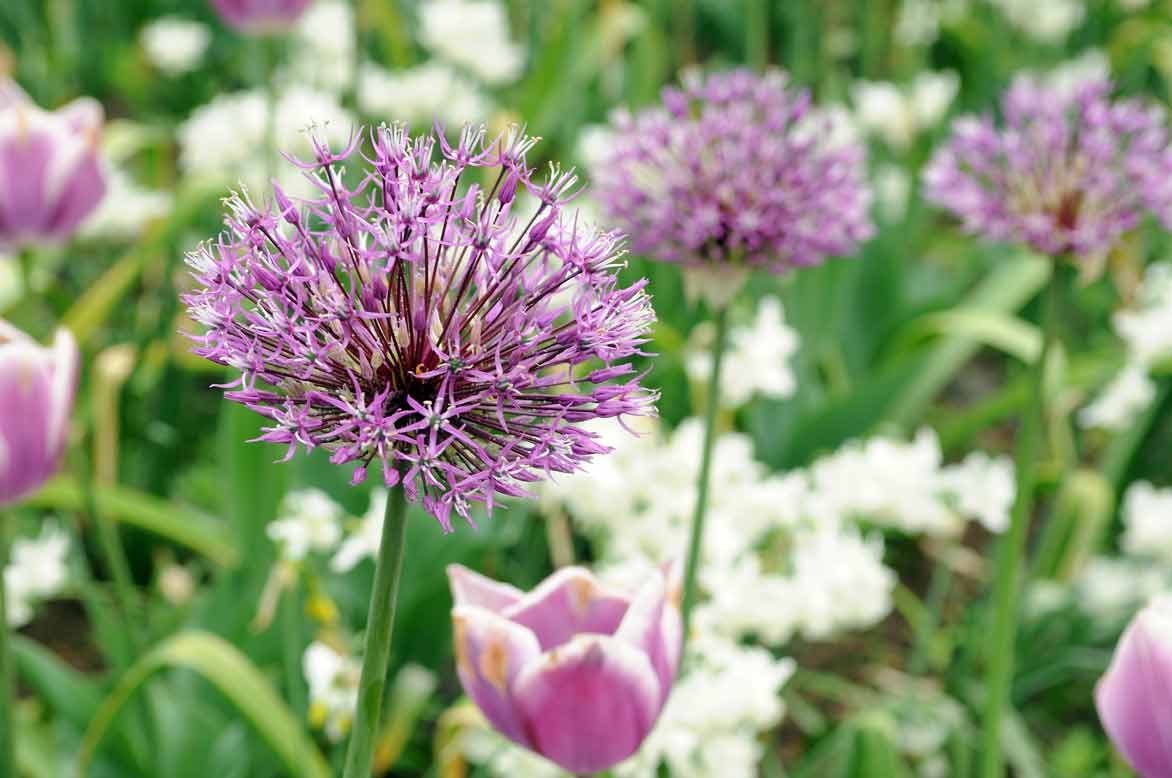

While alliums combine effortlessly with perennials they tower above on slender stems, they are equally splendid alongside tulips
Discover more allium pairing ideas in our guide: “Allium: 9 Successful Planting Combinations”
Useful resources
Discover:
- Our full collection on our website: you’ll find the most beautiful varieties of ornamental alliums
- Should you cut back or leave Allium flowers after blooming? Read our expert’s article on our blog
- Care guide: Allium, ornamental onion: 10 must-have varieties
- Care guide: Allium, ornamental onion: which varieties to choose?
- Care guide: Allium: 9 successful planting combinations
- Care guide: Planting Alliums
- Care guide: How to dry Allium flowers?
- Tutorial: How to preserve and use wild garlic?
- Our Planting depth guide for spring bulbs
- Subscribe!
- Contents




































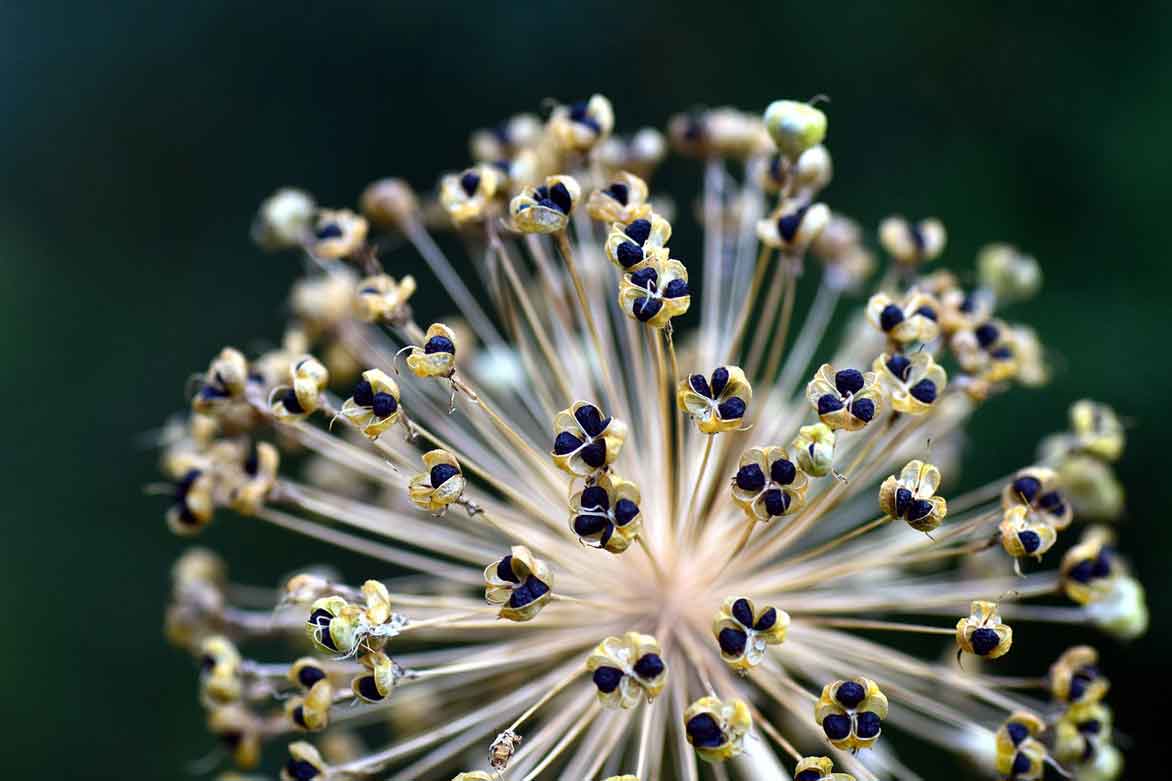

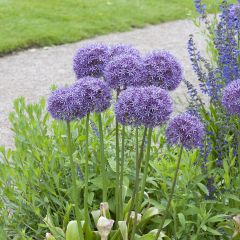



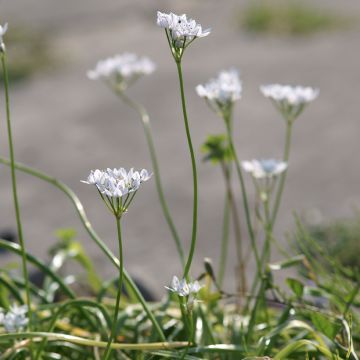
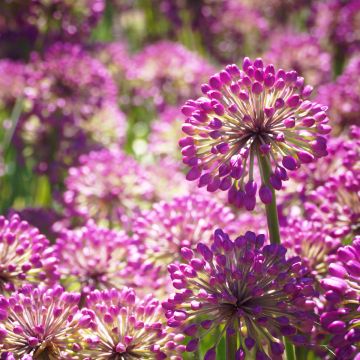
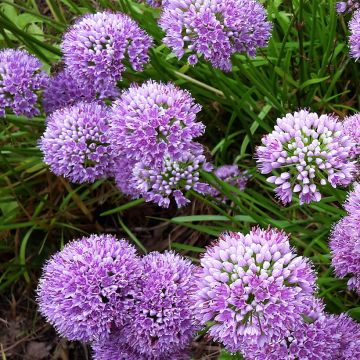
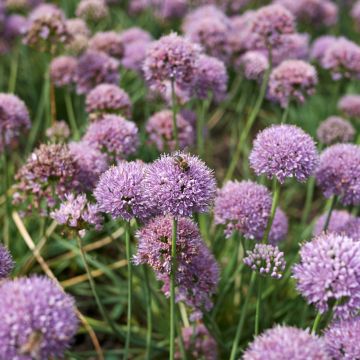
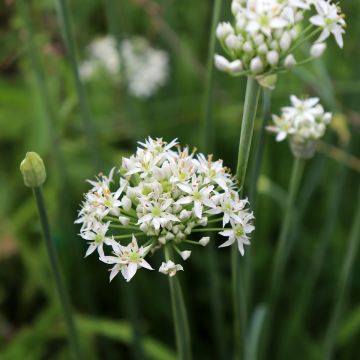
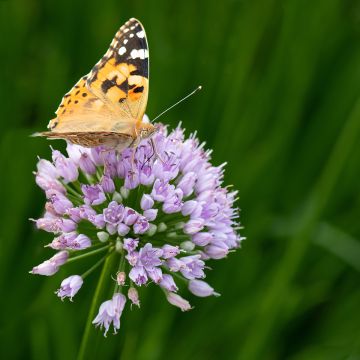
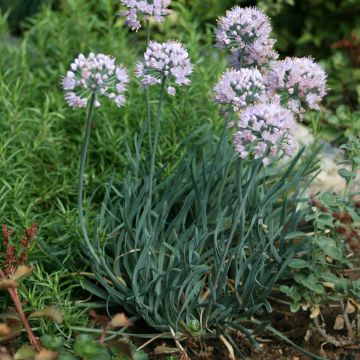
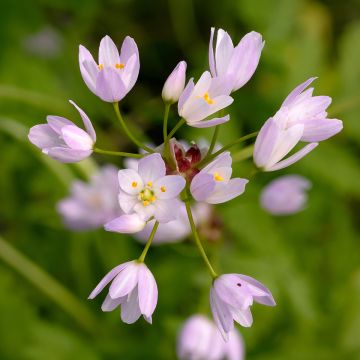
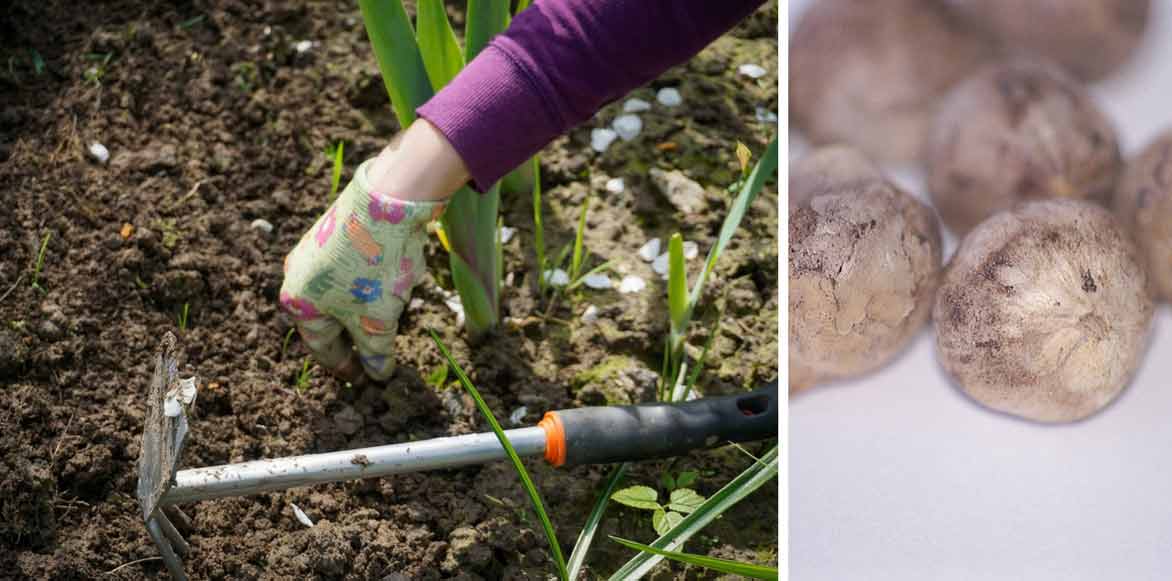
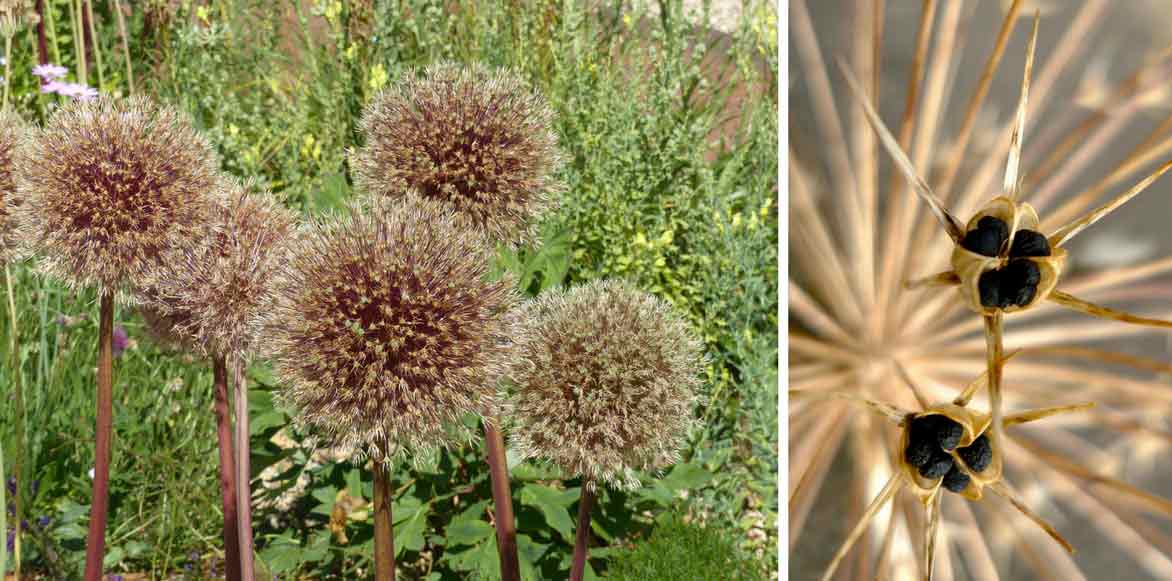
Comments